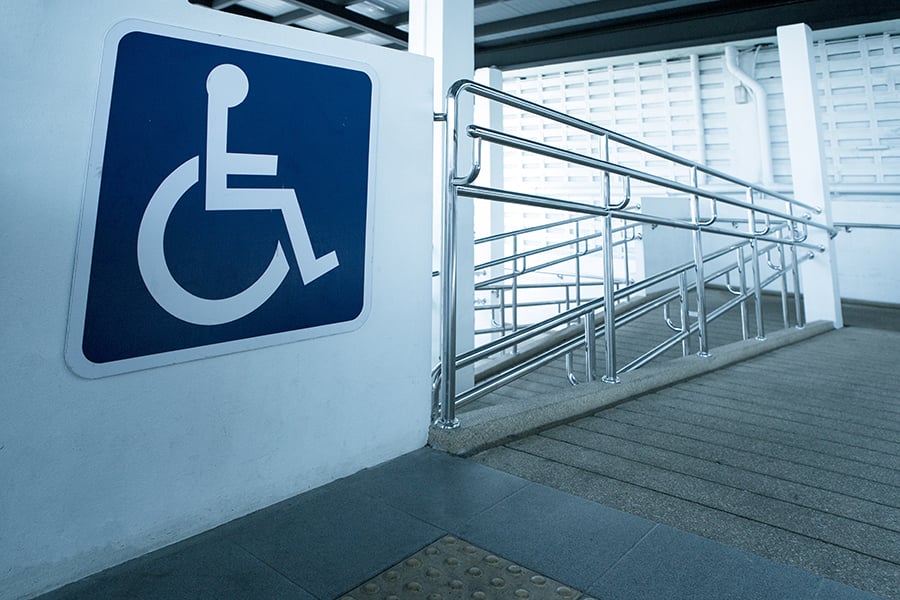
Guest blog by Holly Welles. Holly is a real estate blogger interested in the ever-shifting landscape of the market. You can read more of her work on her own blog, The Estate Update, and follow her on Twitter @HollyAWelles.
Imagine arriving at work and finding the doors locked. That's how the world feels for the disabled when they encounter inaccessible buildings. While the Americans With Disabilities Act (ADA) requires certain upgrades for newer buildings, owners and tenants in older facilities need to take initiative to make these buildings accessible.
You can't overstate the importance of accessibility. Clients look elsewhere if they feel uncomfortable in your office, creating real business impact. Plus, part of providing reasonable accommodations to employees means ensuring they have the tools they need to perform essential job functions.
1. Adding Ramps to All Areas
Individuals who rely on wheelchairs find curbs and stairs problematic. Installing ramps at all entrances and exits allows these people ingress and egress. These devices also help chairs navigate short flights of interior stairs.
The ADA specifies strict slope requirements — overly steep ramps prove difficult or impossible to navigate. If the lift extends beyond six inches, you must install handrails. These assist people who use devices like canes and walkers.
Longer spans can exhaust people, so ramps should also be designed for comfort. Provide adequate landing or rest areas every 12-18 feet and include runoff areas on landings to keep water from accumulating.
2. Redesigning Bathrooms
The ADA requires those renovating commercial buildings to upgrade bathrooms for accessibility. You may need to enlarge existing stalls during your remodel to allow wheelchairs to enter easily. When doing so, you’ll need to maintain an adequate fixture count to support your occupant load. This may require you to make bathrooms bigger overall.
Also, building owners should add grab bars to toilet stalls — the ADA now requires vertical grabs. This isn't only for individuals in wheelchairs. People with balance challenges or conditions like arthritis in the knees need handles to gently lower themselves without falling.
3. Make Common Areas and Meeting Rooms Accessible
You might be surprised by how many aspects of a conference room you’ve never properly considered. Is the seating around your conference table so crowded, you need to rearrange furniture to let someone in a wheelchair attend a meeting? Are chairs roomy enough to sit individuals comfortably?
What about your reception area? Do you provide chairs so clients with difficulty standing for extended periods can wait comfortably? Can guests in chairs reach the complimentary Keurig machine or is it on a high table?
Inclusivity means ensuring common and meeting areas conform to accessibility standards. If your office is so small you have difficulty maneuvering, imagine the challenges those with different physical abilities face.
Thankfully, business owners can easily make changes to increase accessibility in shared spaces. Allow adequate space between furniture for people to move freely even if they use mobility aids. If you offer refreshments, place them where everyone can partake.
4. Provide Ergonomic Equipment
The ADA requires employers to make reasonable accommodations for applicants and employees who are qualified individuals with disabilities unless doing so presents an undue hardship. You have to buy desks and chairs anyway. To comply with the spirit of the law, invest in ergonomic furniture that benefits those with handicaps.
Desks that adjust from a seated to a standing position assist people with chronic conditions like fibromyalgia. Such individuals find regular physical activity alleviates pain and discomfort. Text-to-speech software helps the visually impaired read information on the computer screen. Mousepads with wrist support ease the suffering of workers with carpal tunnel syndrome.
5. The Sensory Experience Matters
Bright lights and loud sounds can wreak havoc on people with autism disorders. Some people on the spectrum leave jobs because of chaotic environments that stress them. Yet teams who embrace diversity — including people with disabilities — can often boost team performance and tackle new ideas more effectively. Keep in mind that it also costs a significant sum to replace a departing employee.
Similarly, bright fluorescent lights and strong scents trigger migraine attacks in susceptible individuals. Strive to create a quiet and orderly work environment. Keep noise levels low and replace glaring overheads with softer track lighting or desk lamps. Ban strong perfumes and body sprays.
After all, your work environment affects everyone’s performance. These steps not only increase accessibility, but also quickly resolve some more common disturbances for all your employees.
6. Ask Employees What They Need
Many employees with disabilities hesitate to ask for reasonable accommodations. Yes, the law mandates you must provide these. But many have lost previous positions due to their health. As a result, they try to hide their condition from their current employer.
Let staff members know you value inclusivity. Ask all employees — not only those you suspect have disabilities — what accommodations could improve their productivity. Honor these requests if possible and remember that investing in your team’s success can only help your business.
Accessibility Matters in a Commercial Space
Accessibility matters to clients and staff alike. Making building upgrades to improve inclusivity keeps you in legal compliance and benefits your bottom line. Whether you’re on the hunt for a new office lease or looking to optimize your current space, remember to keep accessibility in mind.
Here are a few other articles we think you'll enjoy:
Building Class For Corporate Tenants
The Top Five Office Building Amenities You Should Look For
How Important is Building Condition When Leasing a Commercial Space?
Subscribe to our blog for more CRE tips!!










